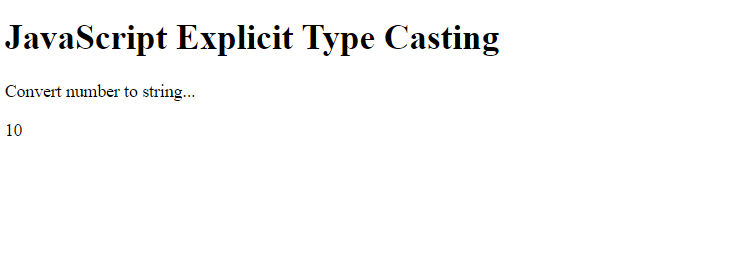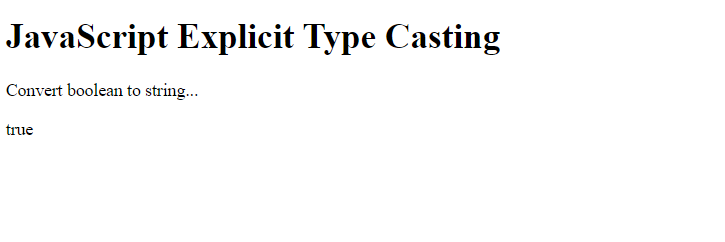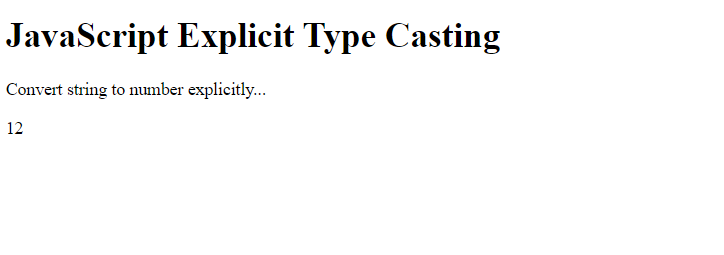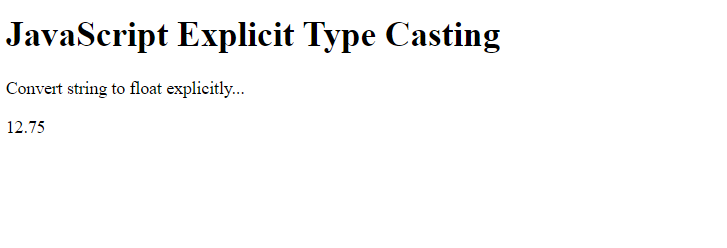23 Feb JavaScript Type Conversion
Type casting in JavaScript is to convert one type to another.
- Implicit Conversion: Automatic
- Explicit Conversion: Manual, using built-in functions
Implicit Conversion
The compiler automatically converts one type to another. This is called Implicit Type Casting. Let us see how this works and converts boolean to number implicitly.
Let us see an example that converts boolean to number implicitly i.e., automatically:
|
1 2 3 4 5 6 7 8 9 10 11 12 13 14 15 16 17 18 19 20 |
<!DOCTYPE html> <html> <body> <h1>JavaScript Implicit Type Casting</h1> <p>Convert boolean to number implicitly...</p> <p id="test"></p> <script> // trur is 1 and false is 0 n = 100 + true; document.getElementById("test").innerHTML = n; </script> </body> </html> |
Output

Explicit Conversion
When the compiler will not be able to convert the type, the developer will do it on its own using some built-in methods. This is called Explicit Type Casting.
Let us now see how to explicitly:
- Convert boolean to number
- Convert number to string
- Convert boolean to string
- Convert number to boolean
- Convert string to number
Convert boolean to number
The Number() method is used to convert boolean to number in JavaScript. Let us see an example:
|
1 2 3 4 5 6 7 8 9 10 11 12 13 14 15 16 17 18 19 20 21 22 |
<!DOCTYPE html> <html> <body> <h1>JavaScript Explicit Type Casting</h1> <p>Convert boolean to number...</p> <p id="test"></p> <script> let n; // false is 0 and true is 1 n = Number(false); document.getElementById("test").innerHTML = n; </script> </body> </html> |
Output

Convert number to string
The String() is used to convert number to string in JavaScript. Let us see an example:
|
1 2 3 4 5 6 7 8 9 10 11 12 13 14 15 16 17 18 19 20 21 |
<!DOCTYPE html> <html> <body> <h1>JavaScript Explicit Type Casting</h1> <p>Convert number to string...</p> <p id="test"></p> <script> let str; str = String(10); document.getElementById("test").innerHTML = str; </script> </body> </html> |
Output

Convert boolean to string
The String() is used to convert boolean to string in JavaScript. Let us see an example:
|
1 2 3 4 5 6 7 8 9 10 11 12 13 14 15 16 17 18 19 20 21 22 |
<!DOCTYPE html> <html> <body> <h1>JavaScript Explicit Type Casting</h1> <p>Convert boolean to string...</p> <p id="test"></p> <script> let str; // false is 0 and true is 1 str = String(true); document.getElementById("test").innerHTML = str; </script> </body> </html> |
Output

Convert number to boolean
The Boolean() is used to convert number to boolean in JavaScript. Let us see an example:
|
1 2 3 4 5 6 7 8 9 10 11 12 13 14 15 16 17 18 19 20 21 |
<!DOCTYPE html> <html> <body> <h1>JavaScript Explicit Type Casting</h1> <p>Convert number to boolean...</p> <p id="test"></p> <script> let b; b = Boolean(25); document.getElementById("test").innerHTML = b; </script> </body> </html> |
Output

Convert string to number using parseInt()
The parseInt() method parses a string and returns a number in JavaScript. Let us see an example:
|
1 2 3 4 5 6 7 8 9 10 11 12 13 14 15 16 17 18 19 20 21 22 |
<!DOCTYPE html> <html> <body> <h1>JavaScript Explicit Type Casting</h1> <p>Convert string to number explicitly...</p> <p id="test"></p> <script> let n; // String to number using parseInt() n = parseInt('12.75'); document.getElementById("test").innerHTML = n; </script> </body> </html> |
Output

Convert string to number using parseFloat()
The parseFloat() method parses a string and returns a float in JavaScript. Let us see an example:
|
1 2 3 4 5 6 7 8 9 10 11 12 13 14 15 16 17 18 19 20 21 22 |
<!DOCTYPE html> <html> <body> <h1>JavaScript Explicit Type Casting</h1> <p>Convert string to float explicitly...</p> <p id="test"></p> <script> let n; // String to float using parseFloat() n = parseFloat('12.75'); document.getElementById("test").innerHTML = n; </script> </body> </html> |
Output



No Comments